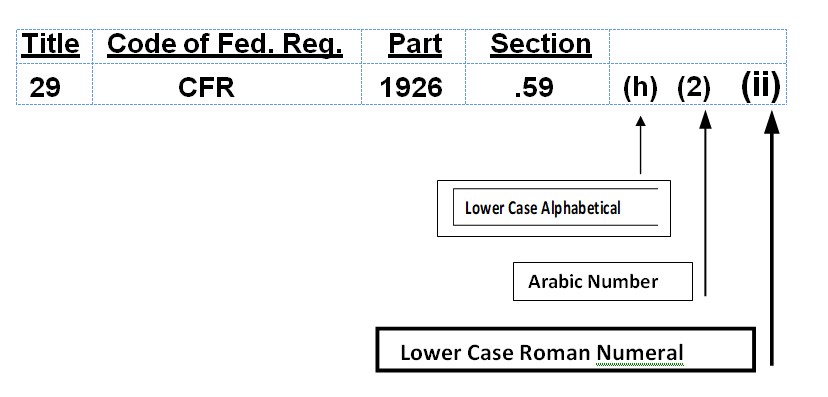1.3: OSHA Subparts
- Page ID
- 18103
\( \newcommand{\vecs}[1]{\overset { \scriptstyle \rightharpoonup} {\mathbf{#1}} } \)
\( \newcommand{\vecd}[1]{\overset{-\!-\!\rightharpoonup}{\vphantom{a}\smash {#1}}} \)
\( \newcommand{\id}{\mathrm{id}}\) \( \newcommand{\Span}{\mathrm{span}}\)
( \newcommand{\kernel}{\mathrm{null}\,}\) \( \newcommand{\range}{\mathrm{range}\,}\)
\( \newcommand{\RealPart}{\mathrm{Re}}\) \( \newcommand{\ImaginaryPart}{\mathrm{Im}}\)
\( \newcommand{\Argument}{\mathrm{Arg}}\) \( \newcommand{\norm}[1]{\| #1 \|}\)
\( \newcommand{\inner}[2]{\langle #1, #2 \rangle}\)
\( \newcommand{\Span}{\mathrm{span}}\)
\( \newcommand{\id}{\mathrm{id}}\)
\( \newcommand{\Span}{\mathrm{span}}\)
\( \newcommand{\kernel}{\mathrm{null}\,}\)
\( \newcommand{\range}{\mathrm{range}\,}\)
\( \newcommand{\RealPart}{\mathrm{Re}}\)
\( \newcommand{\ImaginaryPart}{\mathrm{Im}}\)
\( \newcommand{\Argument}{\mathrm{Arg}}\)
\( \newcommand{\norm}[1]{\| #1 \|}\)
\( \newcommand{\inner}[2]{\langle #1, #2 \rangle}\)
\( \newcommand{\Span}{\mathrm{span}}\) \( \newcommand{\AA}{\unicode[.8,0]{x212B}}\)
\( \newcommand{\vectorA}[1]{\vec{#1}} % arrow\)
\( \newcommand{\vectorAt}[1]{\vec{\text{#1}}} % arrow\)
\( \newcommand{\vectorB}[1]{\overset { \scriptstyle \rightharpoonup} {\mathbf{#1}} } \)
\( \newcommand{\vectorC}[1]{\textbf{#1}} \)
\( \newcommand{\vectorD}[1]{\overrightarrow{#1}} \)
\( \newcommand{\vectorDt}[1]{\overrightarrow{\text{#1}}} \)
\( \newcommand{\vectE}[1]{\overset{-\!-\!\rightharpoonup}{\vphantom{a}\smash{\mathbf {#1}}}} \)
\( \newcommand{\vecs}[1]{\overset { \scriptstyle \rightharpoonup} {\mathbf{#1}} } \)
\( \newcommand{\vecd}[1]{\overset{-\!-\!\rightharpoonup}{\vphantom{a}\smash {#1}}} \)
\(\newcommand{\avec}{\mathbf a}\) \(\newcommand{\bvec}{\mathbf b}\) \(\newcommand{\cvec}{\mathbf c}\) \(\newcommand{\dvec}{\mathbf d}\) \(\newcommand{\dtil}{\widetilde{\mathbf d}}\) \(\newcommand{\evec}{\mathbf e}\) \(\newcommand{\fvec}{\mathbf f}\) \(\newcommand{\nvec}{\mathbf n}\) \(\newcommand{\pvec}{\mathbf p}\) \(\newcommand{\qvec}{\mathbf q}\) \(\newcommand{\svec}{\mathbf s}\) \(\newcommand{\tvec}{\mathbf t}\) \(\newcommand{\uvec}{\mathbf u}\) \(\newcommand{\vvec}{\mathbf v}\) \(\newcommand{\wvec}{\mathbf w}\) \(\newcommand{\xvec}{\mathbf x}\) \(\newcommand{\yvec}{\mathbf y}\) \(\newcommand{\zvec}{\mathbf z}\) \(\newcommand{\rvec}{\mathbf r}\) \(\newcommand{\mvec}{\mathbf m}\) \(\newcommand{\zerovec}{\mathbf 0}\) \(\newcommand{\onevec}{\mathbf 1}\) \(\newcommand{\real}{\mathbb R}\) \(\newcommand{\twovec}[2]{\left[\begin{array}{r}#1 \\ #2 \end{array}\right]}\) \(\newcommand{\ctwovec}[2]{\left[\begin{array}{c}#1 \\ #2 \end{array}\right]}\) \(\newcommand{\threevec}[3]{\left[\begin{array}{r}#1 \\ #2 \\ #3 \end{array}\right]}\) \(\newcommand{\cthreevec}[3]{\left[\begin{array}{c}#1 \\ #2 \\ #3 \end{array}\right]}\) \(\newcommand{\fourvec}[4]{\left[\begin{array}{r}#1 \\ #2 \\ #3 \\ #4 \end{array}\right]}\) \(\newcommand{\cfourvec}[4]{\left[\begin{array}{c}#1 \\ #2 \\ #3 \\ #4 \end{array}\right]}\) \(\newcommand{\fivevec}[5]{\left[\begin{array}{r}#1 \\ #2 \\ #3 \\ #4 \\ #5 \\ \end{array}\right]}\) \(\newcommand{\cfivevec}[5]{\left[\begin{array}{c}#1 \\ #2 \\ #3 \\ #4 \\ #5 \\ \end{array}\right]}\) \(\newcommand{\mattwo}[4]{\left[\begin{array}{rr}#1 \amp #2 \\ #3 \amp #4 \\ \end{array}\right]}\) \(\newcommand{\laspan}[1]{\text{Span}\{#1\}}\) \(\newcommand{\bcal}{\cal B}\) \(\newcommand{\ccal}{\cal C}\) \(\newcommand{\scal}{\cal S}\) \(\newcommand{\wcal}{\cal W}\) \(\newcommand{\ecal}{\cal E}\) \(\newcommand{\coords}[2]{\left\{#1\right\}_{#2}}\) \(\newcommand{\gray}[1]{\color{gray}{#1}}\) \(\newcommand{\lgray}[1]{\color{lightgray}{#1}}\) \(\newcommand{\rank}{\operatorname{rank}}\) \(\newcommand{\row}{\text{Row}}\) \(\newcommand{\col}{\text{Col}}\) \(\renewcommand{\row}{\text{Row}}\) \(\newcommand{\nul}{\text{Nul}}\) \(\newcommand{\var}{\text{Var}}\) \(\newcommand{\corr}{\text{corr}}\) \(\newcommand{\len}[1]{\left|#1\right|}\) \(\newcommand{\bbar}{\overline{\bvec}}\) \(\newcommand{\bhat}{\widehat{\bvec}}\) \(\newcommand{\bperp}{\bvec^\perp}\) \(\newcommand{\xhat}{\widehat{\xvec}}\) \(\newcommand{\vhat}{\widehat{\vvec}}\) \(\newcommand{\uhat}{\widehat{\uvec}}\) \(\newcommand{\what}{\widehat{\wvec}}\) \(\newcommand{\Sighat}{\widehat{\Sigma}}\) \(\newcommand{\lt}{<}\) \(\newcommand{\gt}{>}\) \(\newcommand{\amp}{&}\) \(\definecolor{fillinmathshade}{gray}{0.9}\)OSHA Subparts
Chapter XVII of Title 29 Department of Labor section of the code of federal regulations (CFR) is designated for the Occupational Safety and Health Administration. In this textbook we will discuss two parts under Chapter XVII, Part 1910 is the standard for Occupational Safety and Health Standards for General Industry, and Part 1926 is the standard for Occupational Safety and Health Standards, commonly known as the "Construction Industry Standards." Under each part, major blocks of information are broken down into Subparts.
The major Subparts in the 1910 Standard includes:
- Subpart A - General
- Subpart B – Adoption and Extension of Federal Standards
- Subpart C – reserved
- Subpart D – Walking-Working Surfaces
- Subpart E – Means of Egress
- Subpart F – Powered Platforms, Manlifts
- Subpart G – Occupational Health and Environmental Control
- Subpart H – Hazardous Materials
- Subpart I – Personal Protective Equipment
- Subpart J- General Environmental Controls
- Subpart K- Medical and First Aid
- Subpart L – Fire Protection
- Subpart M – Compressed Gas and Compressed Air Equipment
- Subpart N- Materials handling and Storage
- Subpart O- Machinery and Machine Guarding
- Subpart P – Hand and Portable Power Tools
- Subpart Q- Welding, Cutting, and Brazing
- Subpart R – Special Industries
- Subpart S – Electrical
- Subpart T – Commercial Diving Operations
- Subpart U- COVID-19 Emergency Temporary Standard
- Subpart Z – Toxic and Hazardous Substances
The major Subparts in the 1926 Standard includes:
- Subpart A - General
- Subpart B - General Interpretation’s
- Subpart C - General Safety and Health Provisions
- Subpart D - Occupational Health and Environmental Controls
- Subpart E - Personal Protective and Life Saving Equipment
- Subpart F - Fire Protection and Prevention
- Subpart G - Signs, Signals and Barricades
- Subpart H - Materials Handling, Storage, Use and Disposal
- Subpart I - Tools - Hand and Power
- Subpart J - Welding and Cutting
- Subpart K – Electrical
- Subpart L – Scaffolds
- Subpart M – Fall Protection
- Subpart N - Helicopters, Hoists, Elevators and Conveyors
- Subpart 0 - Motor Vehicles, Mechanized Equipment and Marine Operations
- Subpart P - Excavations
- Subpart Q - Concrete and Masonry Construction
- Subpart R - Steel Erection
- Subpart S - Underground Construction, Caissons, Cofferdams and Compressed Air
- Subpart T - Demolition
- Subpart U - Blasting and Use of Explosives
- Subpart V - Power Transmission and Distribution
- Subpart W - Rollover Protective Structures; Overhead Protection
- Subpart X – Stairways and Ladders
- Subpart Y – Diving
- Subpart Z – Toxic and Hazardous Substances
- Subpart CC - Cranes and Derricks in Construction
Each Subpart may be further divided into more detailed sections, such as the following example from the construction standard:
Subpart D
Occupational Health and Environmental Controls
|
1926.50 |
Medical Services and First Aid. |
|---|---|
|
1926.51 |
Sanitation. |
|
1926.52 |
Occupational Noise Exposure. |
|
1926.53 |
Ionizing Radiation. |
|
1926.54 |
Non-ionizing Radiation. |
|
1926.55 |
Gases, Vapors, Fumes Dusts and Mists. |
|
1926.56 |
Illumination. |
|
1926.57 |
Ventilation. |
|
1926.58 |
Asbestos, Tremolite, Anthophyllite and Actinolite. |
|
1926.59 |
Hazard Communication. |
Paragraph Numbering System
Using section 59 of the 1926 standard, let's examine the structure and workings of the numbering system.
29 CFR 1926.59(h)(2)(ii)
Employee training shall include at least the physical and health hazards of the chemicals in the work area.
|
Title |
Code of Federal Regulations |
Part |
Section |
|---|---|---|---|
|
29 |
CFR |
1926 |
.59 |
The first number 29 represents the title.
Next we have CFR, which represents the Code of Federal Regulations. Next we have 1926, which is Part 1926.
Next is the section number, in this case Section 59 for hazard communication. If the number were 150, you would relate it to fire protection. Section 451 relates to scaffolding.

The next division is the paragraph. As you can see, the first tier of paragraphs beneath the section level will be numbered in parentheses (a), (b), (c), (d), etc. as will all further designations. If you only had three major paragraphs of information under a section, they would be numbered 59(a), 59(b), 59(c).

The next level of numbering involves the use of Arabic numbers in parentheses. As illustrated, if there were three paragraphs of information between subheadings (a) and (b), they would be numbered (a)(l), (a)(2), and (a)(3).

The next level uses the lowercase Roman numeral. An example would be between paragraphs (2) and (3); If there were five paragraphs of information pertaining to Arabic (2) they would be numbered (2)(i), (2)(ii), (2)(iii), (2)(iv), and (2)(v).
Most Frequently Cited Standards
OSHA statistics are updated annually. Use the following link Frequently Cited OSHA Standards to search for your industry. Enter “submit” for list of NAICS codes then enter the sector code. Use the following links to view annual report of OSHA’s most frequently cited standards for 2021:
Required Recordkeeping
A major responsibility of OSHA involves recordkeeping and reporting. Employers of 11 or more employees must maintain occupational and injury records as they occur. Some employers, such as those in retail trade, finance, insurance, real estate, and service industries are not subject to a records request from OSHA.
Recordkeeping and reporting are one of the primary tools used to obtain statistical data on workplace accidents and is an effective tool for employer trending of safety related incidents at worksites.
Accidents
Any on-the-job accident that results in the death of an employee, or the hospitalization of three or more employees, must be reported to the nearest OSHA office within 8 hours.
These recordkeeping and recording statistics are maintained on a calendar year basis. OSHA requires that an annual log, (OSHA 300 Log) be kept and posted at each establishment.


